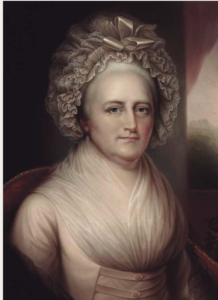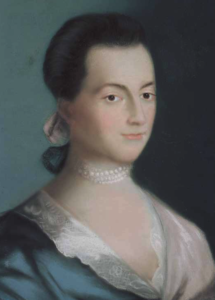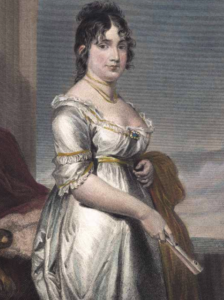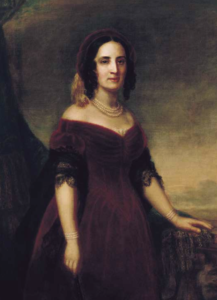
Women of the White House by Amy Russo
This is a good time for a new book about First Ladies. They are the forgotten heroes (or is it heroines?) of American history, largely eclipsed by the brighter light cast by famous husbands. Their stories have not received the attention they deserve.
Some were reluctant to assume the role of First Lady, either because they did not perceive themselves capable or because they feared making their private lives public. Others enthusiastically embraced the idea, seeing both challenges and opportunities.
The brief biographies in Amy Russo’s new book, Women of the White House, no more than 2-4 pages each, including pictures, are mildly informative. The book is well put-together with regard to layout and graphic design. It looks great and conveys high quality. Russo’s selection of First Lady portraits is especially impressive. An outstanding collection of this caliber is rarely found in a single volume.
All of this having been said, it is unfortunate that modern cultural currents flow through the author’s comments below and in the Afterword. The author’s ideological agenda mars what could have been a remarkable work. It occurs to us that, with a few modifications, this would make an excellent coffee table book — the photos and portraits are wonderful, and the short timelines that record the important events of each First Lady’s life provide some interesting information at a glance.
Introduction
First ladies, unlike presidents, serve by circumstance in a role that has been defined by culture rather than the Constitution. There is no job description and there are no codified rules. In that there is agency. Those who have come to shape the legacy of the East Wing the most have embraced its capacity for influence with political acumen, passion and the ability to act as allies and agents of change.
These sentences require some digestion. Russo implies that because First Ladies are neither mentioned nor regulated by the Constitution, they are not constrained by it. “Agents of change†both expresses hubris and implies political orientation. Russo seems to applaud First Ladies who amass and exercise political power, whether on behalf of a president, or to fulfill personal political ambitions. Her use of words such as ally and agency connote an agenda driven by identity politics and “intersectionality.”
Below are a handful of the first ladies from Russo’s book, with some additional context based on works covered previously at WWTFT.
Martha Dandridge Washington

Wives of public men in the 18th century were expected to host formal dinners, see to the comfort of house-guests, and keep domestic order. When Daniel Parke Custis died suddenly in 1757, Martha Dandridge had to raise four young children alone, manage a large estate, and oversee slaves. All of it was preparation for her future marriage to George Washington.
… she was left with a 17,500-acre plantation and nearly 300 slaves, making her incredibly wealthy at the age of 26.
…
Though she was mourning the loss of her husband, Martha met George Washington the following year, in 1758. However, with no financial need to marry, their partnership would need to be built on love. George, then a distinguished colonel in the Virginia Regiment, was known to have enjoyed the company of women, but with Martha, he was smitten.7 By 1759, the two had tied the knot.
By all accounts their marriage was a loving one, although circumstances required stoicism from both parties. During the American Revolutionary War (1775), General Washington spent eight years at camps on the front line. Martha joined him for almost half that time and actively participated in camp life. She cared for the sick, knitted hundreds of pairs of wool socks for winter campaigns, and entertained important visitors. Washington considered Martha’s presence so vital that he asked Congress to pay her travel expenses (and he wasn’t yet president.)
When the war ended in 1783, the Washingtons returned home to Mount Vernon until 1787 when Washington agreed to preside over the Constitutional Convention. In 1789 when George was unanimously elected president, Martha was not enthusiastic about moving to New York and becoming the first First Lady, (though the term had not yet been invented). Nonetheless, she determined to set a proper standard for the future. They moved again when the Capitol was relocated to Philadelphia.
They missed life at Mount Vernon, a longing that only grew during Washington’s tumultuous second term. He struggled to hold the new nation together despite foreign wars, emerging partisanship and tension within his Cabinet.
The Great Divide by Thomas Fleming, (reviewed here.)
Secretary of State Thomas Jefferson made the task more difficult. An ardent supporter of the French Revolution, Jefferson contrived to undermine Washington’s neutrality policy by secretly engaging in activities favorable to the French. Notably, Martha Jefferson was the first presidential wife to die prior to her husband’s presidency (in 1782). This reviewer wonders if Jefferson’s presidency (1801 – 1809.) would have been less calamitous had there been a First Lady to check his worst inclinations.
Abigail Smith Adams
 Abigail was raised to run a household, bear and educate children, and help advance her husband’s ambitions, all of which she did admirably well. She was his “confidant, advisor, and dearest friend, forging a bond between the two long before Adams became president.†First Family by Joseph Ellis (reviewed here) is one of, if not the best book about the Adams family.
Abigail was raised to run a household, bear and educate children, and help advance her husband’s ambitions, all of which she did admirably well. She was his “confidant, advisor, and dearest friend, forging a bond between the two long before Adams became president.†First Family by Joseph Ellis (reviewed here) is one of, if not the best book about the Adams family.
When John was selected as a delegate to the Continental Congress, a friend warned that participation would brand him as a traitor and end his legal practice, and perhaps his life. John was not deterred. He was convinced a break with England was inevitable, perceiving that the old world was rooted in coercive forms of government and the new on the basis of consent. The majority of delegates thought that reconciliation was possible. Adams and developing events persuaded them otherwise.
Abigail shared John’s convictions, but worried about what form independence would take. She wrote to him: “What code of laws will be established? How shall we be governed to retain our liberties?†She opposed slavery and fretted that citizens willing to deprive others of their liberty “cannot be equally committed as those who hold to the principal ‘of doing to others as we would that others should to us.’†(First Family)
At home, Abigail managed the farm, cared for their four young children, and dealt with a series of domestic challenges, an epidemic of small pox among them. Her letters reveal the difficulties she had to surmount during the four years her husband was in Philadelphia. When Adams became president in 1797, Abigail did not welcome the prospect of moving to the new Capitol in Washington. John had no such misgivings: “I never wanted your advice and assistance more in my life.â€
Abigail’s voice, though not equal to John’s in national affairs, was influential. Their voluminous correspondence reveals her devotion to her husband, their children, and to the formation of the new nation.

Dolley Payne Todd Madison
Dolley Payne Todd’s first husband, new baby, and in-laws died of Yellow Fever in 1773. Only Dolley and her 18-month-old son survived.
She married James Madison in 1797. They lived in Philadelphia for three years before then-President Thomas Jefferson appointed Madison Secretary of State. The Madisons moved to Washington in 1801.
Dolley Madison did much to define the role of the President’s spouse, known only much later by the title First Lady—a function she had sometimes performed earlier for the widowed Thomas Jefferson. Wikipedia
Dolley Madison quickly established a reputation for being a vivacious and politically astute hostess. The Madison home was a political powerhouse second only to the White House in influence. Dolley combined Martha Washington’s charm with Abigail Adams’s outspoken voice. She used both to advance her husband’s career.
As First Lady she enlarged White House gathering areas and her prowess as a hostess. She was an important political asset for the new president, acting as a liaison to opposition leaders and smoothing the way for legislation Madison supported.
James Madison was an intellectual giant who, arguably, contributed more to the writing of the Constitution in 1787 than anyone. To prepare, he read dozens of books on government. Yet, for all his talent and smarts, Madison could be stubborn, manipulative, and opportunistic. See James Madison by Richard Brookhiser (reviewed here). Dolley was the perfect antidote.
Sarah Childress Polk
Russo writes:
Upon her husband’s election in 1844, Sarah Polk emerged as one of the most powerful women of her time, cleverly wielding influence within the confines of patriarchal society through her strategic political partnership with the president.
 The “patriarchal society” in which she lived did not confine her. Sarah used its strictures to promote James’s political ambitions by inventing her persona of religiosity, deference, and feminine modesty. To suggest otherwise is to demean her. Nobody in 1844 thought they lived in a patriarchy. Once again, Russo allows her modern wokeness and presumed moral superiority to tarnish her work.
The “patriarchal society” in which she lived did not confine her. Sarah used its strictures to promote James’s political ambitions by inventing her persona of religiosity, deference, and feminine modesty. To suggest otherwise is to demean her. Nobody in 1844 thought they lived in a patriarchy. Once again, Russo allows her modern wokeness and presumed moral superiority to tarnish her work.
Sarah recognized James’s political promise and pushed him forward. She shared his passion for small government and continued territorial expansion. She saw what he could do, and what they could do together. James quipped that “had he remained the clerk of the legislature, Sarah would never have consented to marry him.†Lady First by Amy S. Greenberg (reviewed here).
She was not a cipher for James or anyone else. She refused Suffragettes’ entreaties to publicly support their cause (considering it unseemly for a president’s wife), but persuaded the ladies of her private sympathies and mobilized them to help James get elected.
Sarah was James’s trusted intermediary, campaign manager, and communications director. She charmed his proponents and disarmed his adversaries. Her warm relationship with members of Congress and the military, established when James was Speaker of the House of Representatives, was immensely helpful in building support for their agenda of territorial expansion.
James K. Polk was brilliant, introverted, dour, taciturn, impatient, and driven — not attributes associated with winning friends and delivering votes. Sarah did both.
Unlike their predecessors, the Polks had no children and not the least interest in having any. Sarah had slaves to keep the home fires lit, a luxury that Abigail Adams did not have, nor wished to acquire.
Although there is a great deal of evidence that Sarah initially considered herself the very best kind of slave mistress, her solicitude for her slaves did not extend to freeing them, paying them, or to take measures that would improve their lives, if they would disrupt hers. (Lady First)
This lack of empathy for slaves extended to orphaned children of close relatives whom the Polks declined to bring into their home, although that was the standard in the South at the time (they did contribute to their support elsewhere.)
The policies of the Polk administration, particularly Indian removal and war with Mexico, were not universally admired at the time, and detractors are not in short supply now.
A Country of Vast Designs by Robert W. Merry (reviewed here) does not endorse everything the Polk Administration did, but gives credit for what was accomplished. Merry points out that during his four-year term, Polk extended the domain of the United States more than any other president by opening 25 million acres of land for settlement, paving the way for an enormous influx of immigrants (and fellow Americans) seeking better lives. He lowered tariffs, created an independent Treasury, wrested Oregon from the British, and concluded the Mexican-American War.
Amy S. Greenberg points out in Lady First that “[Sarah Polk] understood how to put the White House to work in service of the nation. She increased the number of weekly receptions at the White House, and transformed them to reflect the [Mexican-American] war now underway.” In addition, in order to bolster her (otherwise somewhat unassuming) husband’s public image as a military leader, she repurposed the Scottish march Hail to the Chief to signify his arrival at rallies and other events. This staunch support of the US military was instrumental in her husband’s success as president, and starkly contrasts with the actions of a particular future First Lady …
Hillary Clinton
It should come as no surprise that Russo dedicates a substantial portion of her work to discussing Hillary Clinton, crediting her with “redefining the place of presidential spouses in U.S. politics.†WWTFT regulars will likely predict that our assessment of Clinton’s contributions is rather different, namely that Clinton’s performance neither advanced the status of First Ladies in particular, nor that of women in general. In fact, a case can be made that she achieved the opposite.
The Clintons entered the White House under the banner of “two for the price of one,” a standard soon tattered by Bill’s philandering and Hillary’s imperious overreach as Chair of the Commission on Health Care Reform. Notably, she was the first First Lady to be officially appointed to a federal position. Furthermore, the scheming of the Clinton committee, the resulting recommendations, and the expanded federal power necessary to implement them were categorically repudiated by the bulk of the electorate.
Russo’s personal biases become clear throughout the final illustrations, and the sycophantic musings on Michelle Obama and Jill Biden contrast sharply with the pompous admonishments of Melania Trump. Russo is quick to point out the perceived flaws and myriad “controversies” associated with the latter, but speaks of the former with nothing but florid praise. Ultimately, this is indicative of a general issue with the book at large — while some subjectivity is to be expected in an encompassing work such as this, Russo’s attempts to apply the standards of 21st-century leftist ideology to the whole of the American story, turn what ought to be a history into an agenda-driven narrative in which the real story takes a backseat.
In the afterword, political science professor Anthony J Eksterowicz poses the question, “what will it take to elect the first female president of the United States?” The inherent strangeness of tacking such a question onto the end of this particular book aside, its implications devalue the efforts of the women discussed in the preceding pages. Since when does biology indicate qualification? The less said about it the better.
 The posts are coming!
The posts are coming!


0 comments
Kick things off by filling out the form below.
Leave a Comment